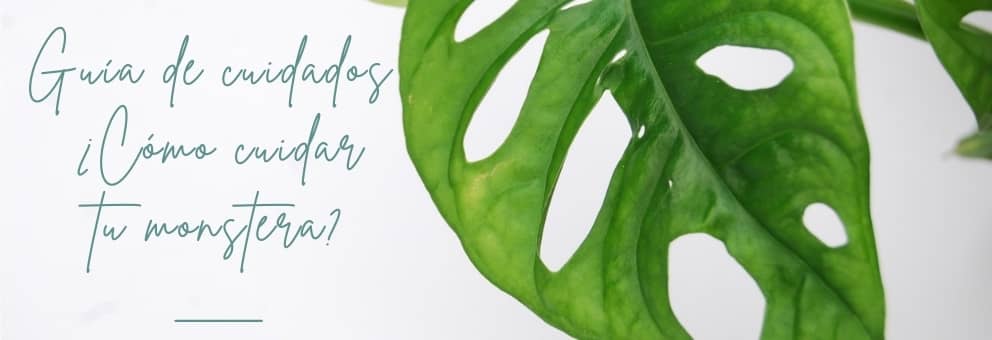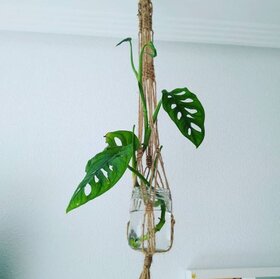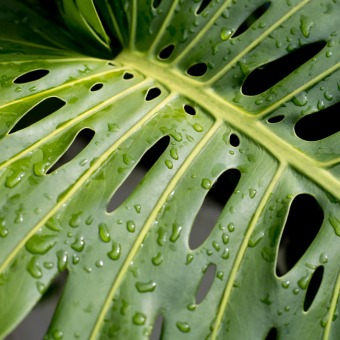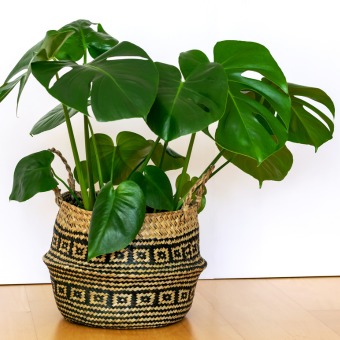-
Care guide: how do you take care for your Monstera?

It loves posturing and is currently being photographed a lot, on Instagram we see many photos and videos of the monstera with hashtags such as #monsteramonday. This plant is also known as Adam's rib. It is one of the most popular houseplants at the moment and interior designers love it. This tropical climbing plant is a member of the arum family and grows mainly in tropical rainforests from southern Mexico to northern Argentina. Now you can bring it into your home too, how do you create the right circumstances in your living room or bedroom for this famous plant. With the following practical tips you can create the best conditions for your monstera to grow happily.
our tips for the care of a monstera
As always in our blogs we teach you, among other things, how to take care of plants to make the most of all their splendour and the happiness they can bring us. In this case we are talking about the monstera, an indoor plant, but also an outdoor plant (in milder climates, such as in the south of Spain, the coasts and the Canary Islands). By following these tips step by step you will be sure to enter the green phase and have a monstera in top form.

light
A monstera feels at its best in an environment with sufficient light. However, the plant should never be placed in full sun. So do not place it directly next to a window where the sun's rays are coming in. If it spends too much time in the sun, it will burn its precious leaves.
If you have found the right spot for your Ceriman, we recommend turning it 80 degrees from time to time, especially in spring and summer, so that it gets light on all sides. Without this movement of the plant during the summer months, the leaves can become very dark. In addition, from April to October the plant can produce new leaves every week. During the winter your Adam's rib will not grow any new leaves, so during the months of November, December, January, February and March it is in 'hibernation' and dormant.
watering
A very important aspect, sometimes we tend to overwater and the frequency of watering the monstera is quite easy. First of all you should keep the soil under control, it should always be a little moist, but not too much: this does not mean that the pot should be waterlogged. It is best to touch the soil inside the pot before you start watering. If the soil still sticks, the deeper soil is still moist and you will not need to water the plant. Too much water is bad for the roots of the monstera: they will rot and will not be able to absorb the nutrition from the soil and will drown from lack of oxygen, resulting in the death of your Adam's rib.

rainwater
Rainwater is always best for your monstera anyway. Why? Rainwater is the most nutritious water for the plant. Some people put their adam's rib (and other plants too with no bad intentions) outside at more than sixteen degrees when it rains, but we don't recommend that. The problem is that you can't really control the amount of rain that falls. Also, the plant is more likely to get aphids outside, which you will then bring inside. The alternative is to spray or mist the leaves of the plant with rainwater at least once a week (and if you like even every day!). The leaves of your monstera will absorb the nutrients.
If you don't have rainwater at your disposal, that's not a problem either; tap water will also do. Leave the water in a watering can overnight, so that the limescale dissolves somewhat. This will prevent white spots on the leaves when the water is sprayed - your Adam's rib will be super photogenic!
moss pole
Adam's rib grows in nature on and around the trunk of a tree. With a moss pole or coconut stake you can simulate this trunk and guide the climbing plant upwards. When your monstera is a few years old, it will grow all kinds of branches. These branches are aerial roots that seek to attach themselves. Tie them carefully to the stake and the plant will grow better and taller.
On our website we offer a Monstera obliqua with a 65 centimetre high coco pole that has been grown in an eco nursery in the Netherlands.
cutting roots and stems
Because the aerial roots can be quite numerous and grow in all directions, many people cut them. This is not a good idea, it is better to guide them upwards or downwards, back into the soil. This respects the natural growth of the plant.
moist moss pole helps growth
Our advice is to always keep the stake slightly damp, so that the roots can grip the pole better. Keep in mind that these roots are just like a kind of string: new leaves will not grow from these roots. If you don't help your monstera to grow upwards a little, eventually your plant will start to look for other ways to grow, above the ground for example.
transplanting
Not for nothing, the monstera owes its name to the fact that it is a real 'monster' that grows through everything. It is precisely for this reason that it is advisable to repot it every year, yes every year! Monsteras are fast growing plants, they generate a lot of extra roots. The perfect transplant would be during the spring into a larger pot (we recommend a pot with 10 to 20% more capacity). If the plant in the pot does not grow aerial roots in the first few years, it is sufficient to provide it with an extra layer of new potting soil every year.
propagating monstera with cuttings
To propagate the monstera, do the following: when you see that the stems start to grow excessively, cuttings should be taken. As this plant grows, it generates very solid and quite rigid aerial roots, which will not dry out and have a long life, until they find a substrate in which to grow.

How to take cuttings from the monstera?
Cut a few stems from the monstera and take cuttings. To cut a Monstera you must have the following: a leaf + stem + aerial root. Cut it 1 or 2 centimetres below the air root. The aerial root may be long or just protrude from the stem as a small lump. You can cut a long air root down to a somewhat more practical size (about 5 centimetres). A lump is also sufficient.
Now you have two options for the stem of the plant to develop roots and grow a new plant from the cutting:
- put them in water in a little bottle or jar
- directly into the soil in a pot.
Cuttings are very delicate and therefore need to be well cared for, but with the right care and pampering you will see that with a little patience and time they will grow roots.
When can you take cuttings from the monstera?
Spring is the best season to take cuttings from the monstera. This is when all the growth juices are flowing through the plant and your cuttings are much more likely to root successfully. It is also better for the mother plant, it will recover sooner after cutting and continue to grow happily.
the best care for cuttings
When caring for cuttings, there are four basic aspects to consider:

- light
When caring for cuttings, there are four basic aspects to consider: - temperature
Make sure the temperature is around 15 to 16 degrees Celsius, even at night. This type of climate suits it and will encourage growth. To achieve this, make a small greenhouse around your cutting. This is easily done with a transparent plastic bag around the pot your cutting and pot will retain heat, humidity and allow light to pass through. Make sure your baby monstera breathes once every four days (or when you see the vapour inside the sachet). Do not duplicate Adam's rib in summer and winter. - watering
The cutting should not dry out: the soil and preferably also the air should remain moist. Monsteras have large leaves, and through these leaves they can lose moisture. And this while the cutting does not have its own well-functioning roots at the beginning. A trick to make sure that the leaves do not evaporate too much water is to roll them up (not too tightly) and fix them with a rubber band. Make sure to unroll the leaf after two weeks, because the leaf is also needed to produce energy. As soon as there are some roots, the cutting can start working faster. - humidity
The small plastic greenhouse also ensures that the air remains nice and moist around the plant.
fertiliser
In time the monstera can give beautiful flowers, but that requires very precise care. To help your Adam's rib grow you can fertilise it once every 2 to 3 weeks. Fertilise it with a liquid fertiliser. Fertilising will stimulate the growth of the plant and therefore also the growth of the flowers. Combined with proper watering, misting showers will create the unique circumstances that will make your monstera shine!
pruning
As we already know monstera is a climbing plant and can grow quite large. If you don't want it to grow so much because it takes up too much space you can prune it. But always underneath some of the aerial roots, so that you can plant the pruned part to get a new monstera. Do not remove the stem where the flowers grew, because the new flowers will appear from the same stem.

We think it is best to let the plant be guided every week to the next strong point or to let it grow on the wall or on the ceiling. You will see how cool it is and turn your living room or bedroom into a green jungle.
how to care for a monstera plant recap
-
Average Light Levels
An adaptable houseplant that will do well in moderately lit spaces. -
Moderate Watering
Water well and then wait until the soil is almost dry before watering again. -
Temperature
Average room temperatures between 19 and 25 Celcius are fine. -
Feeding
Feed once a month during spring and summer.
Which monstera do you want to take care of?
Now that we know in detail how to take care of your monstera, we would like to introduce you to the selection of monsteras in our online shop. Maybe you would be interested in having more monsteras at home? We have a star product: Monstera deliciosa from a nursery in The Netherlands. All plants from these suppliers are of the highest quality and that's why we also offer our 30-day quality guarantee for all the plants. Choose and buy your favourite monstera and take care of it like a #monsteralover!
No comments found.